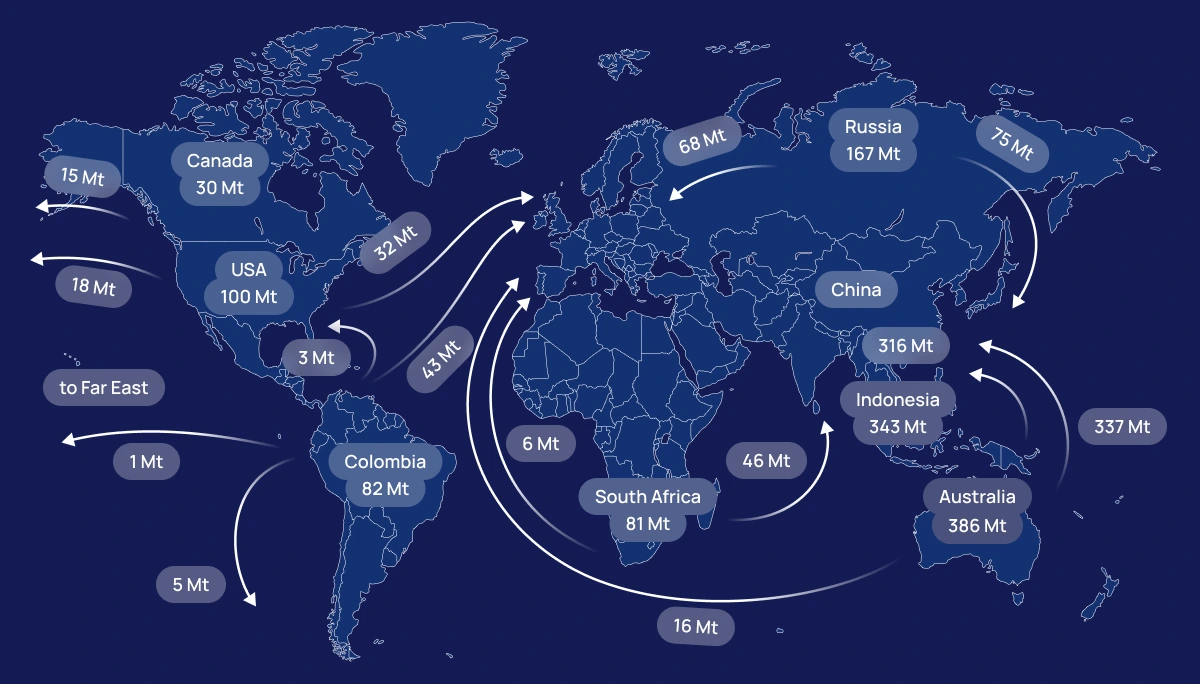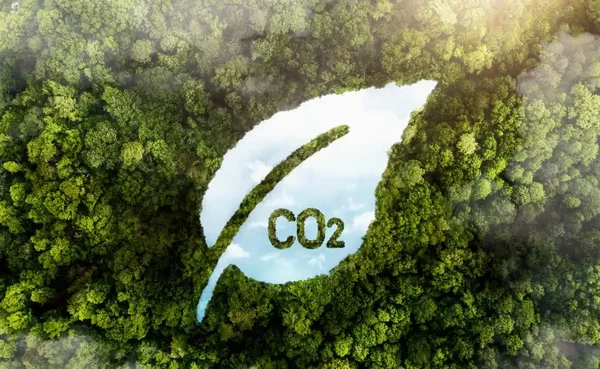Will Europe cope without Russian coal?
Europe's dependence on Russian coal.
Europe's dependence on energy resources from Russia is very big. There have been many publications on this subject in the last few months. Natural gas continues to flow from Russia to most European countries in a wide stream, and May brought a stabilization of natural gas prices, among others due to the good supply of liquefied natural gas and the fact that some countries, however, paid for the gas in rubles (Italy, Germany).
The situation with electricity prices is completely different. In view of their very strong growth, especially in Poland last month (May 2022), we want to take a better look at the situation on the coal market. We want to understand how the introduced coal embargo from Russia from August 2022 may affect electricity prices in the coming months, quarters or years in countries dependent on the prices and supplies of this raw material.
Russia is the world's third largest exporter of hard coal, behind Indonesia and Australia.
The directions of hard coal flows are presented in the graph below (note, data for 2018).

Source: Enerace graphic, Data: IEA
In 2021, Russia was responsible for 54% of total hard coal imports to the European Union. According to the Brussels think tank Bruegel, the figure was 70% for steam coal, which is used to generate electricity and heat. Russian metallurgical coal, used to produce iron and steel, accounts for around 20 to 30% of the EU's coal imports. Importantly, in this article we will focus only on hard coal, as lignite is practically not imported by Europe. Lignite production in Europe in 2021 amounted to 275 million tons with a consumption of 276,78 million tons).
Coal imports to the EU in 2021. Source: own materials based on data from the European Commission
The dependence of individual European Union countries on coal imports (in general, not only from Russia) is presented in the graph below.
As you can see, Poland imports hard coal, but less than 15%; only 2% of imported coal (about 0.25 million tons per year) goes to commercial and industrial power plants.
Hard coal import to Poland. Source: Forum Energii
As we read in the announcement of the Ministry of State Assets, " energy companies practically do not use imported coal: 99,7% of hard and lignite coal for the energy sector comes from Polish mines (...). Importantly, lignite is not imported to the power plants in Poland at all.
As summarized by the BiznesAlert.pl portal, " in 2021, about 8 million tons of thermal coal were imported from Russia to Poland, which means a decrease by 1,1 million tons compared to 2020 and by 2,5 million tons compared to 2019. Coal from Russia is imported mainly by private entities. It is used to meet the needs of households, private enterprises (e.g. processing plants, vegetable producers, etc.) and small heating plants. Thermal coal imports (million tonnes) in 2021: Russia – 8,03, Colombia – 0,60, Kazakhstan – 0,51, others – 0,11, USA – 0,08. Limiting coal imports from the Russian Federation will make it necessary to supplement the missing coal volumes in the Polish economy. This will be done by:
- increasing production in Poland (which is already happening, see the chart below)
- increasing imports from other directions.
In addition to import by rail (Russia, Kazakhstan), coal goes to Poland through ports from countries such as Australia, Colombia, and the United States. "
The analysis shows that the import of coal can be replaced mainly by increasing the import from overseas directions.
Coal mining and sales in the period 06.2021 - 03.2022 (Production: blue line, sales: brown line) Source: Polskirynekwegla.pl.
Coal production has recently increased significantly due to high demand caused by the expected coal embargo from Russia. In March 2022, production reached 5,48 million tonnes. The last higher monthly production at the level of 5,5 million was recorded in November 2018. This year's March sales level supported the increased production and amounted to 5,46 million tonnes, which is the highest result since October 2020.
Polska Grupa Górnicza (PGG) (eng: Polish Mining Group) plans to increase the annual production in 2022 by 1 million tons - up to 24 million, originally 23 million were planned. The commissioning of a new longwall (800.000 tons) requires investments lasting 18 months and 200 million PLN. Currently, banks do not grant loans for this type of purpose. The possibilities of increasing production will depend on the "climate" around coal in the European Union. Coal companies make investment decisions dependent on such elements as the amount of costs of CO2 emission allowances or the stability of the regulatory policy on coal issues.
Tauron Wydobycie in 2021 increased monthly production from 300 to 500 thousand tons. Annual production planned for 2022 will be practically the same as in the previous year and will amount to approximately 5,1 million tonnes.
Unfortunately, the situation started in 2021 and the present one has significantly depleted not only the reserves of natural gas, which we wrote about in our previous publication, but also the reserves of coal in Poland. Increased demand affects the level of coal inventories. At the end of March 2022; it amounted to only 1,35 million tons compared to 5,8 million tons a year earlier; We have not recorded such a low inventory for 13 years.
Coal stocks in the period 03.2017 - 03.2022. Source: Polskirynekwegla.pl.
Production, import and consumption of coal.
It is worth emphasizing that currently 2 countries (Poland and the Czech Republic) in Europe produce hard coal.
While several countries consume hard coal in Europe:
Poland is by far the largest producer of this raw material in Europe, and countries such as Germany, France, the Netherlands and Italy must quickly look for alternative delivery routes to Russia.
Source: own materials based on data from Eurostat, Eurocoal, Polski Rynek Węgla.
Coal in the energy mix
To see the impact of coal on electricity prices it is obvious we need to analyse the energy mix of a country. In 2021, coal was responsible for 72,4% of electricity production in Poland. But again, for electricity production practically none of Russian coal was taken!
Source: Forum Energii
For comparison, in Germany, coal was responsible for less than 28% of electricity production in 2021 and majority of the coal deliveries came from Russia.
Source: Clean Energy Wire.
What's next for electricity prices?
On the 2nd June 2008, i.e. before the collapse of the American investment bank Lehman Brothers (5th September 2008), coal prices with delivery for the next year (ie for 2009) reached the level of 216,43 dollars per tonne. At that time, it was the highest level of coal prices in the 21st century.
On 6th October 2021, another peak was recorded, when the price climbed to 182,60 dollars per tonne due to the galloping prices of natural gas and 'switching' the generation from gas-fired power plants to coal, with the exorbitantly high margins of the latter.
From 24th February 2022, after Russia's invasion of Ukraine, analysts are racing to comment on the next price records (3 March 2022: 264,18 $/t, 23 May 2022: 262.05 $/t).
There is one major question on the part of the end consumers: where is the upper limit of coal prices? Companies do not know whether they should now contract electricity for the next month, quarter, year or maybe several years.
API2 coal price for next year delivery (Year Ahead) Source: Enerace.online
Comparison of electricity prices in Poland and the price of API2 coal with delivery for the next year (Year Ahead). Source: Enerace.online
Summary
It will not be easy, therefore, to replace the quantities needed for Europe by other world exporters. Optimism may be related to the fact that coal imports largely depend on market prices and other factors that may lead to changes in potential coal suppliers for the EU. This is evidenced by, for example, the fact that in recent years traditional suppliers of coal to the EU, such as Ukraine, Venezuela and Norway, have recorded a decline in exports, while new players such as Kazakhstan, Mozambique and the United Kingdom have appeared.
The current PGG negotiations with CHP plants and commercial power plants leave no illusions that electricity prices may remain high in the near future. It is difficult to be under the illusion that the energy producers in Poland that seem to be taking advantage of this moment will give up their excessively high margin (the so-called CDS - clean dark spread). Unless there will be some "top-down" intervention in this matter:
Source: Forum Energii
It seems that the prices are currently following the market fear or sentiment that the import of coal for CHP plants will have to be replaced to some extent with coal from Polish mines, so far mainly supplying commercial power. Is it not so that energy consumers are waiting for a recession or an economic crisis, counting on the next 'purchasing window', and the professional energy sector uses the moment to obtain funds for the energy transformation from end users?
It would be interesting, in the next publication, to deal with the topic of how quickly Europe can obtain coal from directions alternative to Russia.
What is your view on the situation?
Authors: Bartosz Palusiński, Filip Pieńkowski.





